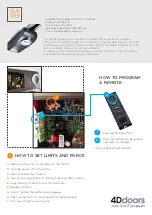
34
If the gate is opening and a vehicle crosses the photo beam, the gate will stop. When
the vehicle leaves, the gate will close automatically after 1second pause.
If DIP17 ON and DIP6 ON
If the gate is opening and a vehicle crosses the photo beam, the gate will continue to
open. When the vehicle leaves, the gate will stop and then closes automatically after
1second pause.
If the complete gate open position is reached before the vehicle leaving, the DIP17 will be
ignored and the automatic closing will be managed in according to the DIP3 position.
PAY ATTENTION: it is highly recommended to check photocells operation at least
every 6 months.
SAFETY ENCODER
The Encoder acts as a safety device both during gate closing and opening by reversing the
motor movement in case of impact detection. Any impact is detected if the motor shaft
turning has been suddenly and unexpected blocked.
If the Encoder is faulty (lack of power, disconnected cables, broken or defective disk), the
gate will not move.
STATE OF ALARM FROM ENCODER impact detection
If the gate is moving and the first encoder impact detection occurs, the gate will reverse in the
opposite direction. If a further encoder impact detection occurs, the gate will reverse again
just for 1second. Then, it will stop and the alarm status will be indicated by the blinking unit
(flashes for 1minute) and by led DL1 (blinks every 2 seconds).
To recover the normal gate operation, it is necessary towait 1 minute or press any control
buttons.
SAFETY STRIP (EDGE - COM)
If it intervenes during opening, it inverts the movement and closes for 2 seconds and then
stops.
If it intervenes during closing, it inverts the movement and opens for 2 seconds and then
stops.
If the safety strip remains engaged (NO contact), no automatic movement is allowed.
In case the safety strip is not installed, this contact must be short circuited with a wire jump
(from EDGE to COM) to permit the gate to operate.
PAY ATTENTION:
it is highly recommended to check safety-strips operation at least every
6 months.
SAFETY STRIP ALARM
After the inversion given by the intervention of the safety edge, the gate stops in alarm mode
and this is signaled by the blinker on for 1 minute.
During or after the minute of alarm, the normal gate operations can be restored by pressing
any push button.
TESTING THE SAFETY STRIP equipment (DIP12 ON)
The DIP12 ON enables the Test of safety strip equipment. The Test is performed every time
the gate completes a full opening. It is suitable only if the safety strip device is equipped with
a dedicated power supply input.
In fact, the safety strip equipment power supply input has to be connected to the A+TEST
and A- outputs (DIP12 ON). Automatically, every time the gate completes a full opening, just
before closing, the control board switches OFF the A+TEST and A- power supply output
for a very short time. While the safety strip power supply is switched OFF, if everything is
working fine the safety strip contact (EDGE - COM) must open. In case the test fails, no other
gate manoeuvre will be allowed and the alarm state will be signalled by the Blinker that will
remain on.
NOT ALL THE SAFETY STRIPS CAN BE TESTED, THUS THE SWITCH DIP12 MUST BE LEFT
OFF.
STOP BUTTON (COM-STOP)
During all the gate movement, the STOP button will stop the motor.
If it is pressed when the gate is still and completely open (or partially open in the pedestrian
position), automatic closing will be temporarily disabled even if DIP3 is turned ON. Therefore,
a new command will be needed to close the gate.
FUNCTIONING IN DEAD MAN MODE WHEN THE SAFETY DEVICES ARE FAILING
If the safety edge fails or remains engaged for more than 5 seconds, or if photocell fails or
remain engaded for more than 60 seconds, the OPEN, CLOSE, K BUTTON and PEDESTRIAN
commands will work only in dead man mode.
The signal that this mode has been activated is given by the blinking of the programming led.
With the blinking of the programming led, the opening and closing operation are allowed
only with the command button pressed and held. The radio commands and that of automatic
closing, will be excluded, since their use in this mode, is not allowed by the norms.
Once the failing safety device is repaired, in automatic after 1 second, all standard
commands that were selected, such as step by step, automatic mode, radio commands and
automatic closing start functioning again.
Note 1:
during this functioning in dead man mode, in case of damage to the safety strips
(or photocells) the photocells (or safety strips) still work by interrupting the operation
in progress.
Note 2:
the stop command is not to be considered a safety command that can be bypassed
in this mode. Therefore, when pressed or damaged, it will not allow any movement
of the gate.
The dead-man operation is only an emergency operation which must be activated for
a very short period and with the complete installation at sight so to have a secure and
safe control of the system. As soon as possible however, the failing safety devices
must be repaired and activated.
FLASHING LIGHT
Connect the flashing light to J1 flashing light outputs, use flashing lights ACG7059 and bulbs
of 40W maximum.
NOTE:
This electronic K board can only supply power to FLASHING LIGHTS with inbuilt
flashing circuit.
PRE-FLASHING function
The DIP8 in the ON position enables the pre-flashing, the FLASHING LIGHT starts working 3
seconds before every movement of the gate.
The DIP8 in the OFF position disables any pre-flashing, the FLASHING LIGHT and the motor
will star at the same time.
OPEN GATE INDICATOR (SIGNAL-COM)
It indicates the gate status: open, partially open or not completely closed.
It switches off only when the gate is completely closed.
During programming, this indicator is active.
NOTE:
if button panels or bulbs are in excess, the electronic board logic will be impaired and
operations might stop.
PROBE
It’s a cable ended with a sensor to detect the motor temperature and, if necessary, to active
automatically the motor warming (code ACG4665).
TECHNICAL SPECIFICATIONS
- Humidity
< 95% without condensation
- Power voltage
230V~ ±10% (120V/60Hz upon
request)
- Frequency
50/60Hz
- Maximum board absorption
30mA
- Interruptions in electricity supply
100ms
- Maximum load of open gate output
3 W (equal to 1 3W bulb or to 5 LEDs
connected in series through a resistor
of from 2.2 Kohm)
- Blinking unit maximum output load
40W with resistive load
- Current available for photocells and accessories 400mA 24Vdc
- Current available on radio connector
200mA 24Vdc
TECHNICAL RADIO SPECIFICATIONS (Only CRX models)
- Reception frequency
433,92MHz
- Impedance
52
Ω
- Sensitivity
>2.24µV
- Excitation time
300ms
- De-excitation time
300ms
- Codes in store
N° 62 total
- All the inputs must be used as clean contacts because the power supply is generated
internally (safe voltage) in the card and it is set in a way to guarantee the use of the double
insulation and reinforced in relation to parts with hazardous voltage.
- Any external circuits connected to the outputs of the control board, must be carried out to
make sure the double or reinforced insulation is used in relation to parts with hazardous
voltage.
- All the inputs are run by a programmed integrated circuit which carries out a self-check at
the beginning of each operation.
TROUBLE SHOOTING
After having carried out all connections, by carefully following the layout and having
positioned the gate in intermediate position, check the correct ignition of LEDS DL2, DL3,
G
B
















































